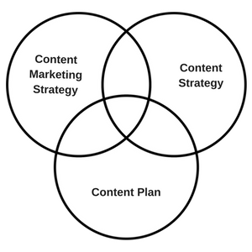
More marketers are focused on content marketing than ever before, and rightfully so. All sorts of content is now widely consumed on social media, and through the creation of fresh and valuable content, companies can increase their search engine optimization efforts.
Gone are the days where you could utilize black hat SEO techniques to cheat their way to the Google's front page. In today's ultra-competitive business environment, companies must be creating content strategically, or risk falling behind their competitors.
But how can companies create an effective content marketing strategy that works?
Understanding Content Marketing (and it's other names)
Content marketing suffers from a definition issue. Since so many differing things can be considered "content", it can be difficult to define it. Convince and Convert's Jay Baer offered possibly the best definition of content marketing that's currently out there, and you can see just how vague it really is...
Content is the emotional and informational bridge between commerce and consumer. Building that bridge requires more than a budget, editorial calendar, and vision. It requires people who care, who love content, and what it can do for people. Not just what it can do for revenue, but rather how it helps people live their lives.
Content helps people in many different ways. It can provide value to the reader through education, it can bring awareness to a topic, it can entertain, and it can do a heckuva lot more. Because content can be so many things and it can have so many different objectives, content marketers must be aware of the dangers of simply creating a Content Plan to document your overall strategy.
With that understanding, let's dive into some of the content-related buzzwords that are use incorrectly on a daily basis.
Content Marketing Strategy
This strategy should refer to a longer, comprehensive document that outlines the why of your content. An ideal Content Marketing Strategy establishes and solidifies your company's voice and communications style, helps you understand how to best communicate with your personas, and it should contain all kinds of research on your company, your competitors and their content, as well as industry influencers and publications.
Put simply, the content marketing strategy is carefully crafted and should contain many pages as to why your company is creating content. Common questions that you should ask when creating your Content Marketing Strategy are:
- why do we need to be creating content?
- how do we best speak to our target audience?
- why does our target audience want to read our content?
Content Plan
This part of a content marketing strategy should cover the how of your content. This plan doesn't need to be as comprehensive, but it should still clearly outline how content will be created, promoted, and engaged with.
Your content plan should be the tactical breakdown of how long it should take to create content, and it should outline the roles of content marketing for your company. These are all essential pieces of your content marketing efforts, and can easily go unmentioned, which will lead to issues down the road.
Be sure to ask these questions when creating your Content Plan:
- how often will blogs be published?
- where will they be published?
- how will they be shared?
- does our content need to be updated periodically?
Content Strategy
While the Content Marketing Strategy establishes a plan of action for the creation of new content, your Content Strategy refers to your current mix of content currently on your website. This goes beyond the scope of a content marketing strategy because it helps companies manage all the content that they have, instead of the how and why they're creating content.
Think of it this way; a company can utilize their Content strategy to identify if there are any gaps in their content. They would then refer to their Content Marketing Strategy to see what topics they can write about and why. Lastly, this company would denote the creation of this new piece of content in their Content Plan.

With a better understanding of the different pieces that make up a Content Marketing Strategy, it's not enough to stop there. In fact, this is actually where the hardest part of creating this strategy comes into play. You need to go through hours or research for your company, your industry, your competitors, your buyer personas, and a ton more.
What to Include in Your Content Marketing Strategy
Remember, there are no real templates for building an effective Content Marketing Strategy. It's up to you to figure out what works best for your organization. Here are a few elements for you to reference that are commonly included in these kinds of strategies.
1) Your Company' Story
Human's have been telling stories for much longer than we've been writing them down. Great stories are easy to remember, and your company's story will resonate with your target audience if you tell it the right way. We have a psychological tendency to listen better when someone is telling a story. We know this because researchers from Princeton found that people in a conversation have better comprehension when listening to a story.
The most important thing here is to think of how you can concisely tell the story of your business. You don't need to dive into your history; rather, keep it simple. Why are you in business? What services do you provide your customers? Answer those questions carefully and you'll get a sense of what to include in your story.
Pro tip: Business owners should include more personal details than larger companies or corporations, and can be a little longer.
2) Buyer Personas & Mapping Your Content
Separate of your company's voice and messaging style, it's essential that you document how to best communicate with your targeted audience. Do your best to answer how your content speaks to the specific challenges and pain points of each of your personas.
It's always a good idea to plan for the future, and you can do that by strategically mapping your content pieces to your personas. This will ensure all of them have content made specifically for them, and it will help you understand what content pieces you'll need to create. Evaluate what part of the sales funnel your content piece lies in. Do your content pieces fall in the TOFU, MOFU, or BOFU stages?
Pro tip: You should be creating your personas before you start on your Content Marketing Strategy.
3) Content Audit
Part of the Content Marketing Strategy should be to evaluate what is currently on the website. Evaluate what pieces of content have been successful and what pieces haven't. Has video content outperformed written content? Understanding this gives you a road map for what needs to be done.
This should be a separate process from mapping your content by persona and where they fall in the funnel because it should help you understand what is working and what's not. For example, are your site visitors spending a lot of time on your product brochure landing pages, but not filling out the form to download them? Consider writing blogs that provide surface-level information on your product and then give people the option to download the product brochure at the end.
Pro tip: If you haven't been tracking form submission rates or contacts generated from a piece of content, look at Google Analytics for data. Evaluate page session duration or bounce rates to get an idea of what's working and what's not.
4) Content Promotion Strategies
Any experienced content marketer will tell you that content creation is only half of the game when it comes to content marketing. Obtaining results from content comes from both the creation and promotion of your content. Your content could be great, but if you're not driving relevant traffic to your content, it won't drive the results that it should.
Content promotion refers to sharing your content on social media or through emails, but it can also be accomplished through outreach and relationship building. Posting your blogs or sharing links to your landing pages with relevant industry publications will help you get more mileage from existing content. Even more, you'll get someone else to share your content and you'll get a link to an outside website which is great for SEO.
Your Content Promotion Strategy should clearly outline what pieces of content will be shared on social media. Will you share only your own content? Or will you share a mix of your content and relevant industry news? It should also document what content will be delivered through email. Lastly, be sure to specify how you will monitor and track the engagement of your content.
Pro tip: Remember, open rates are not accurate indicators of success for email marketing as some email clients allow people to "open" an email by previewing it. That means that they can read the email withouth actually clicking on it and opening it in a new window.
5) Brand Guidelines
For companies that include many teams and content contributors, one of the first parts of a Content Marketing Strategy should be your company's brand guidelines. This includes your voice, tone, messaging styles, language, and other aspects of written communication. It also shares the fonts you use on your website, your color scheme, logos, button styles, and other web elements.
Of course, including these important details isn't enough. These guidelines should be easily accessible for all members of your team(s) and should be strictly adhered to. Brand consistency is extremely important in today's world, and this part of your Content Marketing Strategy should help you stay consistent.
Pro tip: The more information you collect and the more context you provide, the better. Help your team(s) understand when to use specific logos, or how to refer to one of your products or services. Even more, label the colors you use on your website as primary, secondary, tertiary, or even accent colors.
Tying it all Together
I'll be the first to admit that the Science of Content Marketing is not an exact one. The term has been overly defined, and as a result, the confusion surrounding this part of the marketing industry is understandable. However, we can't let that affect how a Content Marketing Strategy is created and what it should entail.
The best strategies are created with the help of hours of research, persona interviews, content maps, and much more. They contain everything necessary for a content marketer to understand your company as well as how to create compelling content for your campaigns. Your Content Marketing Strategy should be comprehensive enough to send to an outside resource so they can contribute to your content efforts.
Does your business have a documented Content Marketing Strategy? We can help! Schedule a consultation with our experts and see how your content can start doing more for you.

